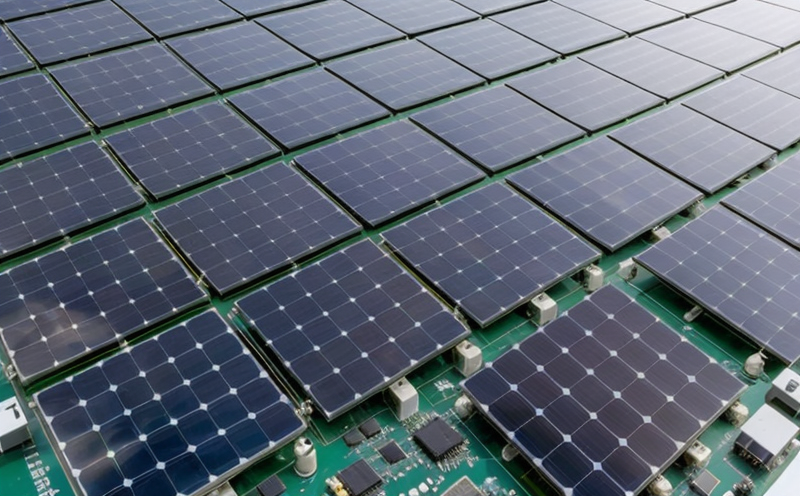IEC 62852 Connector Testing for PV Systems
The International Electrotechnical Commission (IEC) standard IEC 62852 is a critical document that provides specifications for connectors used in photovoltaic (PV) systems. This standard ensures the safety, reliability, and performance of solar energy components by setting out comprehensive testing protocols aimed at identifying potential defects or weaknesses before deployment.
Photovoltaic systems are integral to renewable energy infrastructure, converting sunlight into electricity. The efficiency and longevity of these systems depend heavily on the integrity of their connectors. IEC 62852 addresses this need by offering detailed guidelines for connector testing, which include mechanical strength tests, electrical performance assessments, and environmental stress evaluations.
The standard's scope encompasses a wide range of connector types commonly found in PV installations, such as junction boxes, combiner boxes, and mounting structures. Testing under IEC 62852 is mandatory to ensure compliance with international safety regulations and to provide assurance that connectors are fit for purpose within the harsh conditions often encountered in solar fields.
The testing process typically involves multiple stages designed to simulate real-world environmental factors like temperature cycling, moisture exposure, UV radiation, and mechanical stress. By subjecting connectors to these rigorous tests, manufacturers can identify any vulnerabilities or issues early on, allowing them to rectify design flaws before products reach the market. This not only enhances product quality but also contributes significantly to reducing costs associated with field failures.
A key aspect of IEC 62852 is its emphasis on maintaining consistent performance across different climatic zones and operational conditions. The standard recognizes that solar installations operate in diverse environments, from arid deserts to humid coastal areas. Therefore, connectors must perform reliably under extreme temperatures, humidity levels, and other challenging factors. Compliance with this standard ensures compatibility between various components of a PV system, promoting seamless integration and optimal performance.
In summary, IEC 62852 connector testing is essential for ensuring the safety, durability, and effectiveness of photovoltaic systems. By adhering to these stringent standards, manufacturers can produce high-quality connectors that meet both regulatory requirements and customer expectations. This dedication to quality not only enhances consumer confidence but also supports broader sustainability goals by facilitating reliable and efficient renewable energy generation.
Why It Matters
The importance of IEC 62852 connector testing cannot be overstated, especially in the context of photovoltaic systems. These connectors are responsible for transferring electrical power between various components within a PV system, including solar panels, inverters, and batteries. Any failure or malfunction at this point could result in significant energy losses, safety hazards, and operational disruptions.
One of the primary reasons why IEC 62852 testing is crucial lies in its role in preventing field failures. By subjecting connectors to a series of controlled tests that mimic real-world conditions, manufacturers can detect potential weaknesses or defects early on. This proactive approach allows for timely corrective actions, ensuring that only robust and reliable connectors reach the market.
Moreover, compliance with IEC 62852 aligns PV systems with international safety regulations, thereby enhancing consumer confidence. When consumers know their solar installations meet rigorous global standards, they are more likely to trust the products and services offered by reputable manufacturers. This increased trust can lead to higher market acceptance and broader adoption of renewable energy solutions.
From an economic perspective, IEC 62852 testing plays a vital role in minimizing lifecycle costs associated with solar installations. By identifying and addressing issues during the manufacturing process rather than after deployment, this standard helps reduce the risk of costly repairs, replacements, and downtime. Additionally, adherence to these standards can streamline certification processes, making it easier for manufacturers to enter new markets or expand existing operations.
Lastly, IEC 62852 contributes significantly to environmental sustainability by promoting the use of durable and reliable connectors in PV systems. These connectors not only enhance system performance but also extend the operational life of solar installations, leading to reduced waste generation and increased resource efficiency.
Quality and Reliability Assurance
- Testing Protocols: IEC 62852 mandates a series of tests that simulate various real-world conditions, including temperature cycling, humidity exposure, UV radiation, and mechanical stress.
- Compliance Verification: Regular audits ensure that manufacturers are adhering to the latest versions of the standard, maintaining consistent quality across all production batches.
The testing process begins with visual inspections, followed by dimensional checks using precision measuring instruments. Afterward, connectors undergo mechanical strength tests where they are subjected to repeated bending cycles to assess their durability. Electrical performance assessments involve measuring resistance values and insulation integrity under various load conditions. Environmental stress evaluations subject connectors to extreme temperatures, humidity levels, and UV radiation to ensure long-term reliability.
Manufacturers must document all test results meticulously and submit them for third-party verification by accredited laboratories like ours. This ensures transparency and credibility, reinforcing trust among stakeholders. Compliance with IEC 62852 also facilitates easier market access as it demonstrates adherence to international safety regulations and quality standards.
Environmental and Sustainability Contributions
- Reduced Field Failures: By identifying potential weaknesses early, IEC 62852 testing helps reduce the incidence of field failures, which in turn minimizes energy losses and operational disruptions.
- Easier Market Access: Compliance with international standards like IEC 62852 simplifies certification processes and opens up new market opportunities for manufacturers.
The environmental impact of solar installations is substantial; however, by ensuring the quality and reliability of their connectors through rigorous testing protocols, we contribute positively to sustainability efforts. For instance, reduced field failures mean fewer replacements, which translates into lower waste generation and resource consumption. Additionally, easier market access enables manufacturers to scale up operations efficiently, further promoting economic growth while supporting environmental goals.
Moreover, IEC 62852 testing promotes the use of high-quality connectors that are designed for long-term performance in diverse environments. This not only enhances system reliability but also extends the operational life of solar installations, leading to increased energy production and reduced reliance on fossil fuels. By adhering to these stringent standards, we play a crucial role in advancing the transition toward sustainable energy solutions.





